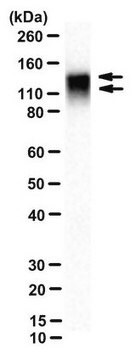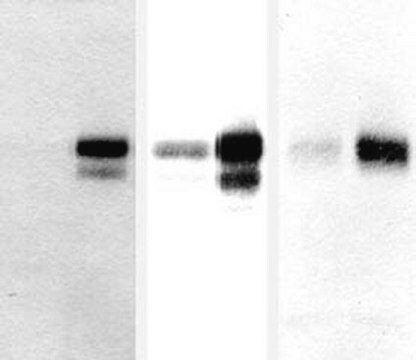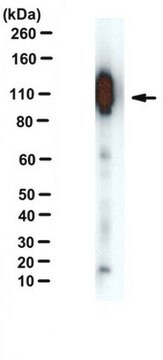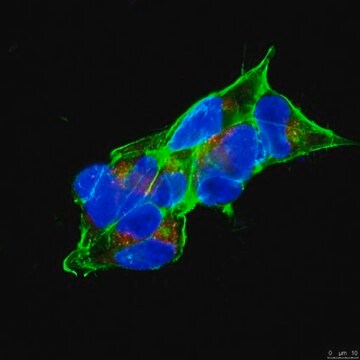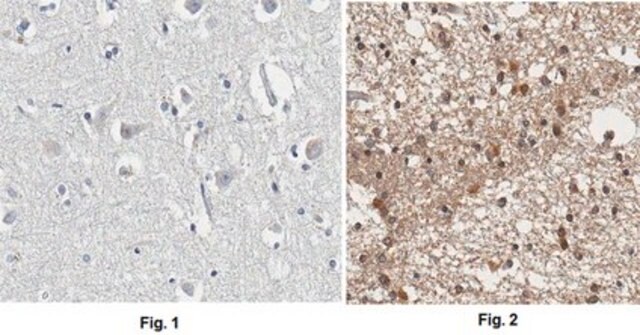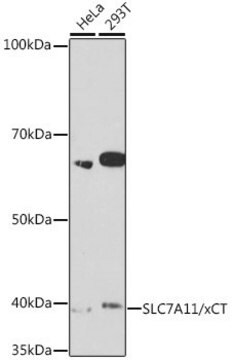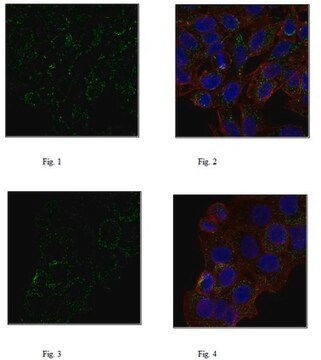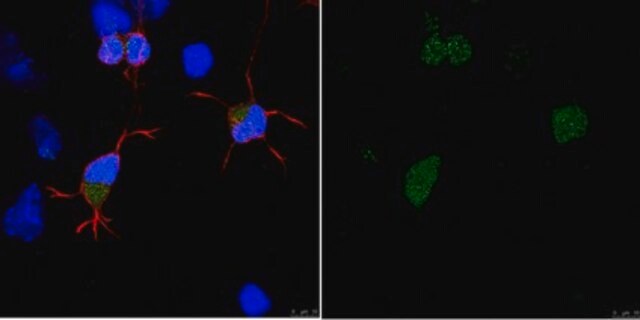MABN2287
Anti-APP Antibody, clone 1D1
clone 1D1, from rat
Sinonimo/i:
Amyloid beta A4 protein, ABPP, APPI, Alzheimer disease amyloid protein, Amyloid precursor protein, Beta-amyloid precursor protein, Cerebral vascular amyloid peptide, CVAP, PreA4, Protease nexin-II, PN-II
About This Item
Prodotti consigliati
Origine biologica
rat
Livello qualitativo
Forma dell’anticorpo
purified immunoglobulin
Tipo di anticorpo
primary antibodies
Clone
1D1, monoclonal
Reattività contro le specie
human
tecniche
ELISA: suitable
flow cytometry: suitable
immunocytochemistry: suitable
immunohistochemistry: suitable (paraffin)
western blot: suitable
Isotipo
IgG1κ
N° accesso NCBI
N° accesso UniProt
Condizioni di spedizione
ambient
modifica post-traduzionali bersaglio
unmodified
Informazioni sul gene
human ... APP(351)
Descrizione generale
Specificità
Immunogeno
Applicazioni
Immunoprecipitation Analysis: A representative lot detected APP in Immunoprecipitation applications (Hofling, C., et. al. (2016). Aging Cell. 15(5):953-63).
Western Blotting Analysis: A representative lot detected APP in WT, but not in APP knockdown HEK293T cells (Courtesy of Dr. med. Peer-Hendrik Kuhn, Ph.D., Institut fur Allgemeine Pathologie und Pathologische Anatomie, Technische Universität München, Munich, Germany).
Immunocytochemistry Analysis: A 1:250 dilution from a representative lot detected APP in HEK293 cell line.
Immunocytochemistry Analysis: A representative lot detected APP in Immunocytochemistry applications (Hofling, C., et. al. (2016). Aging Cell. 15(5):953-63).
Immunocytochemistry Analysis: A 1:10 dilution from a representative lot detected APP in HEK293T cells, but not in cells lentivirally transduced with APP shRNA-1 or APP shRNA-2, both coexpressing GFP as a reporter (Courtesy of Dr. med. Peer-Hendrik Kuhn, Ph.D., Institut fur Allgemeine Pathologie und Pathologische Anatomie, Technische Universität München, Munich, Germany).
Immunohistochemistry Analysis: A representative lot detected APP in Immunohistochemistry applications (Hofling, C., et. al. (2016). Aging Cell. 15(5):953-63).
Immunohistochemistry Analysis: A 1:50 dilution from a representative lot detected APP in human cerebral cortex and human Alzheimer′s brain tissues.
ELISA Analysis: A representative lot detected APP in ELISA applications (Hofling, C., et. al. (2016). Aging Cell. 15(5):953-63).
Western Blotting Analysis: A representative lot detected APP in Western Blotting applications (Hofling, C., et. al. (2016). Aging Cell. 15(5):953-63).
Flow Cytometry Analysis: A representative lot detected APP in Flow Cytometry applications (Hofling, C., et. al. (2016). Aging Cell. 15(5):953-63).
Neuroscience
Qualità
Western Blotting Analysis: 1 µg/mL of this antibody detected APP in 10 µg of HEK293 cell lysate.
Descrizione del bersaglio
Stato fisico
Stoccaggio e stabilità
Altre note
Esclusione di responsabilità
Non trovi il prodotto giusto?
Prova il nostro Motore di ricerca dei prodotti.
Raccomandato
Codice della classe di stoccaggio
12 - Non Combustible Liquids
Classe di pericolosità dell'acqua (WGK)
WGK 1
Punto d’infiammabilità (°F)
does not flash
Punto d’infiammabilità (°C)
does not flash
Certificati d'analisi (COA)
Cerca il Certificati d'analisi (COA) digitando il numero di lotto/batch corrispondente. I numeri di lotto o di batch sono stampati sull'etichetta dei prodotti dopo la parola ‘Lotto’ o ‘Batch’.
Possiedi già questo prodotto?
I documenti relativi ai prodotti acquistati recentemente sono disponibili nell’Archivio dei documenti.
Il team dei nostri ricercatori vanta grande esperienza in tutte le aree della ricerca quali Life Science, scienza dei materiali, sintesi chimica, cromatografia, discipline analitiche, ecc..
Contatta l'Assistenza Tecnica.